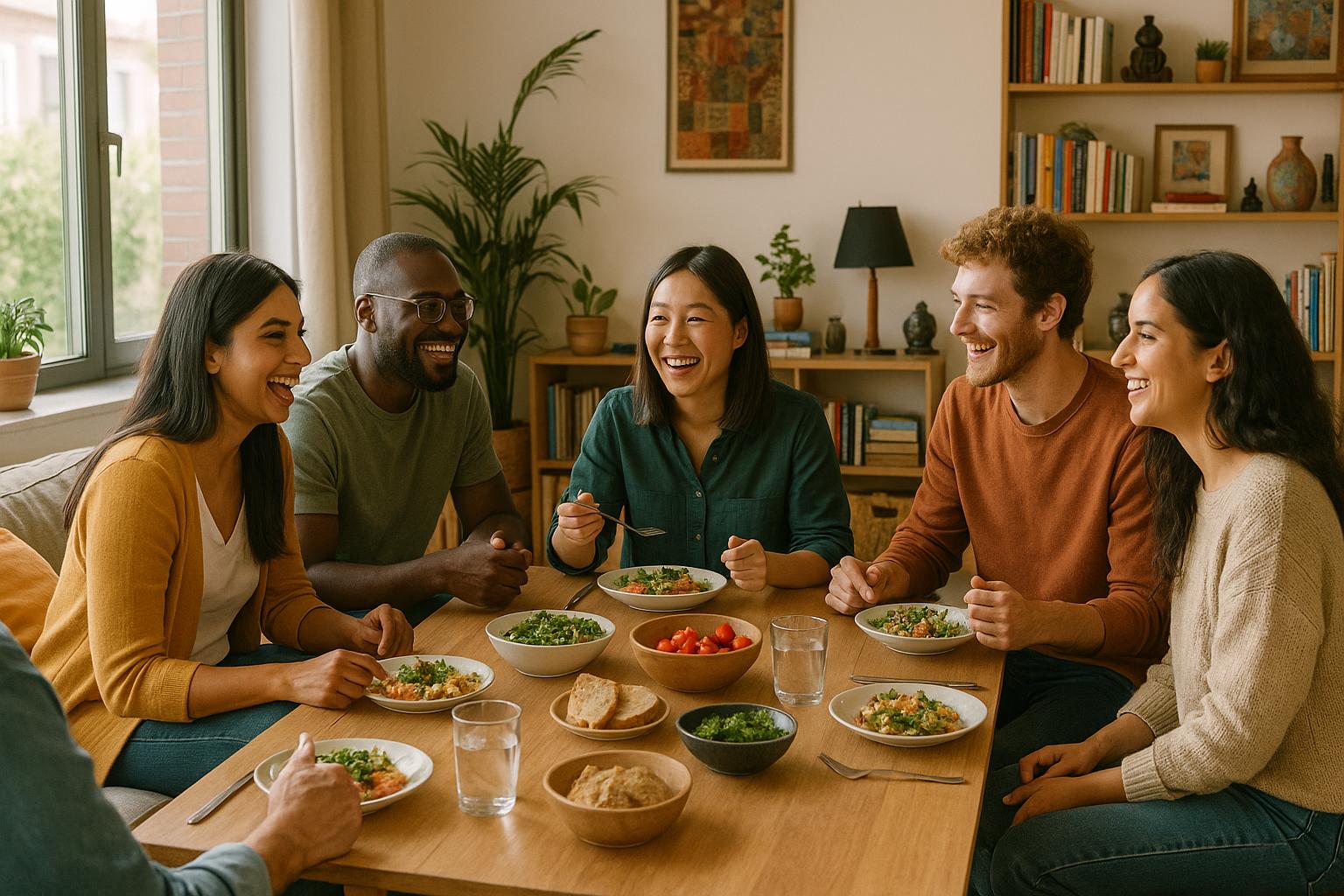Coliving spaces help people connect and adjust when moving to new places, especially across cultures. Here's how:
- Shared Spaces: Kitchens, lounges, and work areas encourage casual interactions and cultural exchange.
- Community Events: Workshops, celebrations, and group activities introduce local traditions and build bonds.
- Support Systems: Buddy programs and welcome sessions help newcomers settle in and learn local customs.
- Digital Tools: Apps for events, language learning, and local guides make integration easier.
For example, coliving spaces like Folk Co-living and EcoIsleta use shared experiences and partnerships with local organizations to create a sense of belonging. Residents report feeling less isolated and more connected to their communities.
Building Community Through Common Areas and Events
Common Areas as Meeting Points
Shared spaces like kitchens, lounges, and work areas naturally bring residents together, sparking casual conversations and moments of cultural exchange. These areas are thoughtfully arranged to encourage interaction while still respecting individuals' need for privacy. For example, open kitchens create opportunities for shared cooking sessions, recipe swapping, and even culinary adventures. Beyond these everyday encounters, organized group events take these connections to the next level.
Group Events and Local Traditions
Structured events build on these daily interactions to offer residents more immersive experiences. In London, Folk Co-living takes this concept further by offering free event spaces to local organizations, a contribution valued at approximately $25,500 (or £20,225). This initiative not only strengthens ties between residents and neighborhood groups but also opens the door to participating in local cultural programs.
Here’s a quick look at how different types of events benefit the community:
| Session Type | Format | Community Benefits |
|---|---|---|
| Professional Skills | Workshops & Webinars | Networking and career growth |
| Creative Arts | Hands-on Classes | Stress relief and self-expression |
| Wellness & Fitness | Group Activities | Better physical and mental well-being |
| Language Exchange | Conversation Groups | Enhanced cross-cultural communication |
EcoIsleta in Gran Canaria offers another unique example. Residents can join neighborhood walks led by local owner Jonatan, where they not only get some exercise but also learn about the area's history and traditions. These walks create a deeper connection to the neighborhood while fostering friendships within the community.
"Coliving is more than just sharing a space - it's about creating experiences that bring people together." - Cactus Coliving
Collaborations with local businesses and organizations further enrich the resident experience. These partnerships pave the way for activities like traditional craft workshops, cultural celebrations, and unique demonstrations. Residents feel more connected to their surroundings while also supporting the local economy.
Professional growth is also a key part of cultural integration. Targeted workshops and networking events help residents build industry connections and gain insights into local business practices. This combination of social and professional opportunities creates a well-rounded community experience that helps residents adapt and thrive in their new environment.
Help Systems for New Residents
Moving to a new place can be daunting, especially when you're adjusting to a different way of life. Coliving spaces recognize this challenge and provide thoughtful support systems to make the transition smoother. These initiatives help residents settle into their new homes while also becoming familiar with the local culture.
Welcome Programs and Local Tips
Many coliving spaces go beyond the basics of move-in day by offering comprehensive orientation programs. These sessions often include guided tours of the property, introductions to fellow residents, and detailed overviews of amenities. But it doesn’t stop there - residents are also introduced to local customs and practices through workshops. For example, these might cover topics like dining etiquette or other cultural norms, helping newcomers feel more at ease in social settings.
Resident Buddy System
To make the adjustment even more personal, coliving spaces often implement a buddy system. This pairs new residents with seasoned members of the community who already have a good grasp of the local lifestyle. These "buddies" act as trusted guides, offering tips about neighborhood gems, explaining unspoken cultural rules, and even helping with language barriers. They also facilitate introductions to other residents, creating opportunities for meaningful connections. Over time, these relationships often grow into strong networks that enhance the coliving experience.
Digital Tools for Community Connection
Digital tools play a key role in helping residents dive into and appreciate local cultures. These tools complement the face-to-face community-building activities mentioned earlier, offering a blend of convenience and connectivity.
Local Discovery Apps
Coliving spaces often rely on specialized apps to help residents engage with local culture. For instance, platforms like Fever make it easy to find nearby events, from traditional festivals to modern art exhibitions. These apps also support hybrid events, bridging the gap between online and offline interactions, so residents can participate in both settings seamlessly.
Online and In-Person Events
Coliving communities are increasingly hosting hybrid events that combine digital and in-person experiences. A recent survey shows that 53% of residents participate in app-based events, while 60% use messaging tools to connect with neighbors. These digital features are reshaping how people interact and foster relationships, often crossing cultural lines.
One standout example is the District Tech platform, which offers a suite of features designed to enhance community life:
| Feature | Purpose |
|---|---|
| Interactive Maps | Help residents find local cultural hotspots |
| Community Guides | Provide insights into local customs |
| Event Calendar | Track both virtual and in-person gatherings |
| Cultural Promotions | Offer discounts on cultural experiences |
Platforms like Sowebuild have further expanded digital connectivity by introducing tools like community newsfeeds, interest-based groups, and online marketplaces where residents can trade skills and services.
In addition, many coliving spaces now include digital tools specifically for language learning and cultural exchange. These platforms pair residents with language partners or cultural mentors, breaking down communication barriers and fostering deeper cultural understanding.
Conclusion: Coliving Connects People Across Cultures
Coliving spaces are reshaping the way people connect and experience life in diverse communities. These shared living environments create opportunities for people from different backgrounds to come together, fostering a sense of belonging and mutual understanding.
The numbers speak for themselves. According to Urban Campus, 82% of residents reported feeling less isolated thanks to community involvement. Similarly, Venn found that loneliness among residents decreased by 50% within six months of moving into coliving spaces. These statistics highlight the meaningful impact of coliving on emotional well-being and social connection.
But it’s not just about the numbers - it’s about the experiences. Coliving spaces actively engage with their surrounding neighborhoods through events and partnerships, creating bridges between residents and local communities. These efforts promote authentic cultural exchange and make residents feel like they’re part of something bigger.
Residents themselves often share how transformative coliving can be:
"In the big cities, sometimes you feel so lonely, but [...] to find out like a place, that feels like home, and people who feel like your family, it's something very unique, and it's very hard to see right now. And that's one of the good things about living in a coliving, is like this feeling of home, community [...] here you feel that you belong. Every single person belongs to this big community."
- Fiona, UK coliving resident
The success of coliving lies in its thoughtful approach to building community. By combining well-designed spaces with digital platforms, coliving spaces make it easier for residents - especially the 72% aged 26–40 - to form meaningful connections in new cultural environments.
Real-life examples further highlight the social impact of coliving. Initiatives like ARK Wembley's partnership with the Al-Hasaniya Women's Centre and Folk Sunday Mills' support for Ukrainian refugees show how coliving extends beyond housing to become a force for cultural understanding and social good. These programs prove that coliving doesn’t just help individuals adapt - it enriches entire neighborhoods.
If you’re looking for a way to experience cultural connection through shared living, Coliving.com offers access to all-inclusive, community-driven spaces where you can truly feel at home.
FAQs
How do coliving spaces help residents adjust to a new culture and feel less isolated?
Coliving spaces create a warm, community-driven environment that makes it easier for residents to settle into a new culture while combating feelings of loneliness. With shared spaces like kitchens and lounges, these setups naturally encourage interaction, helping residents build friendships and supportive connections. On top of that, many coliving spaces organize activities like group dinners or cultural events, giving newcomers plenty of chances to connect and feel part of the group.
Living with people from various backgrounds also opens the door to cultural exchange, offering a chance to learn about local customs and traditions in a friendly and inclusive setting. This shared lifestyle not only smooths the adjustment to unfamiliar surroundings but also boosts emotional well-being by fostering a strong sense of community.
How do digital tools help residents adapt to new cultures in coliving spaces?
Digital tools have become essential in helping residents of coliving spaces settle into new environments and embrace different cultures. They simplify communication, make it easier to organize group activities, and provide access to useful resources. Through apps and platforms, residents can share local tips, plan events that highlight various traditions, and create a welcoming atmosphere for everyone.
What’s more, these tools allow people to connect even before they meet face-to-face, fostering a sense of community right from the start. By making communication seamless and encouraging collaboration, digital platforms help residents bridge cultural gaps and feel more at ease in their new surroundings.
How do coliving spaces work with local communities to encourage cultural exchange?
Coliving spaces play an important role in connecting people with local communities and traditions. By teaming up with local groups and organizations, they encourage residents to participate in events, festivals, and volunteer opportunities. These activities not only help residents immerse themselves in the local culture but also bring support to nearby businesses and preserve traditions.
Many coliving spaces also organize activities like cooking classes, language exchanges, and art workshops. These gatherings give residents a chance to share their own traditions while discovering new ones, fostering a lively and welcoming atmosphere. With a mix of local involvement and a global perspective, coliving spaces make it easier for residents to embrace new cultures and form meaningful relationships.






